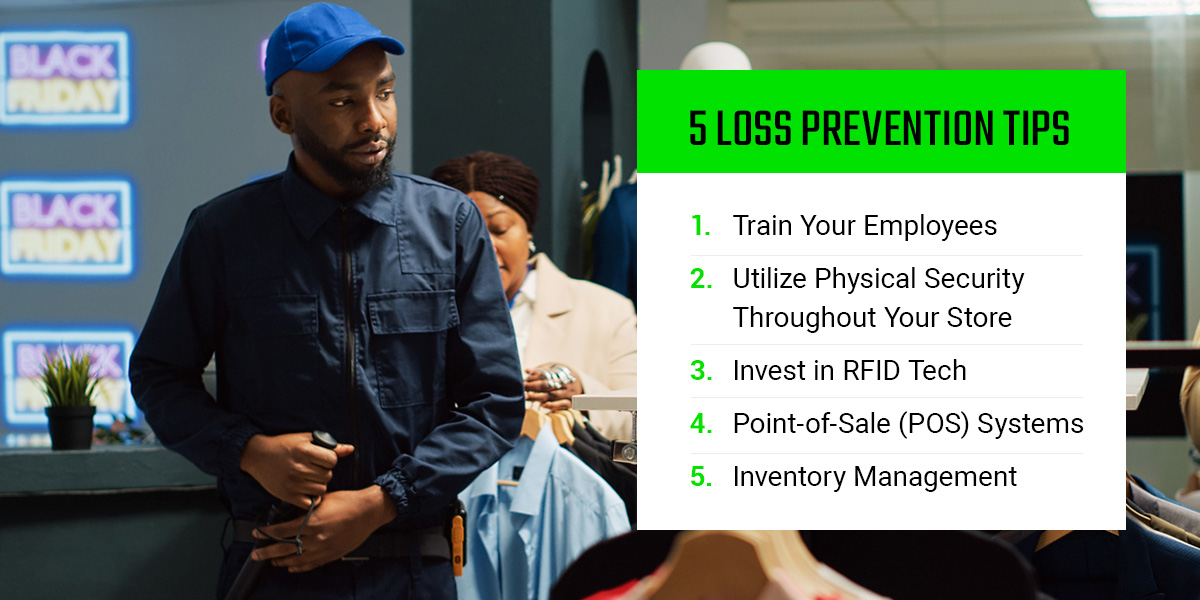
Retail Loss Prevention Tips
September 8, 2023

Retail loss, shrinkage or inventory loss is a growing menace in the industry that frustrates business owners and leaves customers unsatisfied. Retail loss is defined as a discrepancy between the inventory on the balance sheet and the actual inventory due to losses other than sales. These losses are often a result of theft, fraud, operational errors and inventory damage.
Shrinkage affects a business’s bottom line by cutting into the profits and sometimes leads to understocking situations that frustrate and disappoint customers. When left unchecked, shrinkage impacts employee morale, creates a sense of mistrust among employees and leads to lower job satisfaction. Below are actionable tips you can take to ensure loss prevention in retail.
The Types of Retail Loss
The first step toward successful retail loss prevention is identifying the various types and causes of your inventory loss. Here are the main types of inventory loss to be wary of:
- Operational errors: Errors in operations happen when employees make many unintentional inventory management and accounting errors. They might be misquoting prices or overpaying suppliers, which results in discrepancies on the balance sheet. Operational errors are especially common when employees are undertrained and when the company doesn’t have clear operational policies and procedures in place.
- Employee theft: Malicious activities by employees and other members of the business with access to systems, facilities and inventory can also result in retail loss. Employee theft includes acts of vandalism, wastefulness, package pilferage, under-ringing merchandise and sweethearting — when employees might offer unsanctioned perks or discounts to friends or family members.
- External theft: Cases of external theft include customer theft, return fraud or vandalism caused by customers and other people who don’t work in the business. You can also incur losses due to external theft when criminals use stolen or counterfeit credit card information to make unauthorized purchases, which are charged back to you.
- Supplier fraud: Suppliers or vendors might also engage in fraudulent activities that cause retail loss. This kind of fraud can include charging inflated prices, not providing the agreed-upon amount of goods you ordered or fake invoices to receive additional cash for inventory they didn’t provide.

5 Loss Prevention Tips
Retail loss prevention involves tightening the grip on how things run on a daily in your businesses. Below are a few retail loss prevention tips to help you curb the most frequent and impactful causes of retail loss.
1. Train Your Employees
To prevent shrinkage caused by operational and administrative errors, it’s imperative to train your employees on the company’s protocols and best practices. For example, equipping employees with knowledge about your return policies enables them to follow the correct procedures to effectively accept only qualified returns and, therefore, prevent potential cases of return fraud.
Some best practices to prioritize training your employees include:
- How to identify potential shoplifters
- The common tactics used by criminal scammers
- The importance of being attentive on the sales floor
- How to handle the security alarm
- The verbal and non-verbal safety cues to use between team members when there’s a theft or other security incident
2. Utilize Physical Security Throughout Your Store
Physical security guards throughout your store, and especially at the key access points, are a surefire way to deter potential theft by employees or customers. The presence of highly trained and visible security guards intimidates thieves because they know your store takes security seriously.
Your best avenue is to look for professional security guards with military or police backgrounds. They have the experience and training to keep a watchful eye, take immediate action when suspicious activity is observed, de-escalate difficult situations and defend your facility and employees from attacks.
CCTVs and strategically placed mirrors are another layer of physical security that deter potential shoplifters and employees with sticky hands because they know they’re being watched and monitored. Video surveillance is also helpful in identifying criminals after a break-in, as it offers a starting point for investigation.
3. Invest in RFID Tech
Radio-frequency identification (RFID) systems help to reduce retail losses by improving inventory visibility throughout the supply chain. Employing the technology involves attaching RFID tags to products and using a machine to read and deactivate these tags at the checkpoints.
Products with their tags intact sound an alarm at the exit that signals a product with the tag is about to leave the store. This technology helps enable store employees and security personnel to take action fast. It also helps track the real-time movement of products in-store and enhances inventory accuracy to ensure you identify losses fast and reduce the chances of people getting away with theft.
4. Point-of-Sale (POS) Systems
POS systems reduce the likelihood of retail loss by enhancing transaction accuracy, monitoring sales and providing valuable insights into inventory management. They ensure that all sales are accurately recorded and prices are accurately applied. They also help to track real-time inventory levels, transaction logs and receipts and automate cash handling processes. They also tighten internal security by ensuring that only authorized personnel can perform specific functions, such as accessing the cash registers.
When synchronized with security cameras, your POS system can help review transactions alongside visual records to identify any suspicious activities. POS systems with void and return controls reduce the risk of unauthorized refunds and exchanges, which curb the likelihood of return fraud.
Employee training in the proper use of the POS system is also essential for maximum loss prevention.
5. Inventory Management
Implementing a regular inventory management system and delegating to a reliable manager helps to accurately track stock levels and identify discrepancies quickly. Tracking the movement of inventory from suppliers to the store shelves can go a long way in reducing the risk of lost or misplaced items.
You should also conduct periodic inventory audits to identify discrepancies between recorded inventory and available stock. A good inventory management system will also help to identify high-theft items or categories to allow for strategic product placement, increased monitoring and implementation of additional security measures.

How Vigilant Tiger Security Can Help With Retail Loss
Vigilant Tiger is a remarkable security service provider who can help you prevent retail loss by providing you with a strong security presence on the floor. Our professional retail security guards are well-trained former military or police officers with the experience to easily identify and respond to situations that could lead to inventory loss. Our guards conduct themselves with a high level of professionalism and attention to intimidate and deter potential thieves. We also conduct extensive background testing and psychological evaluations to ensure your facility’s security is in good hands.
Put shrinkage to a stop now by contacting us today to get started or learn more about our retail loss prevention services.
